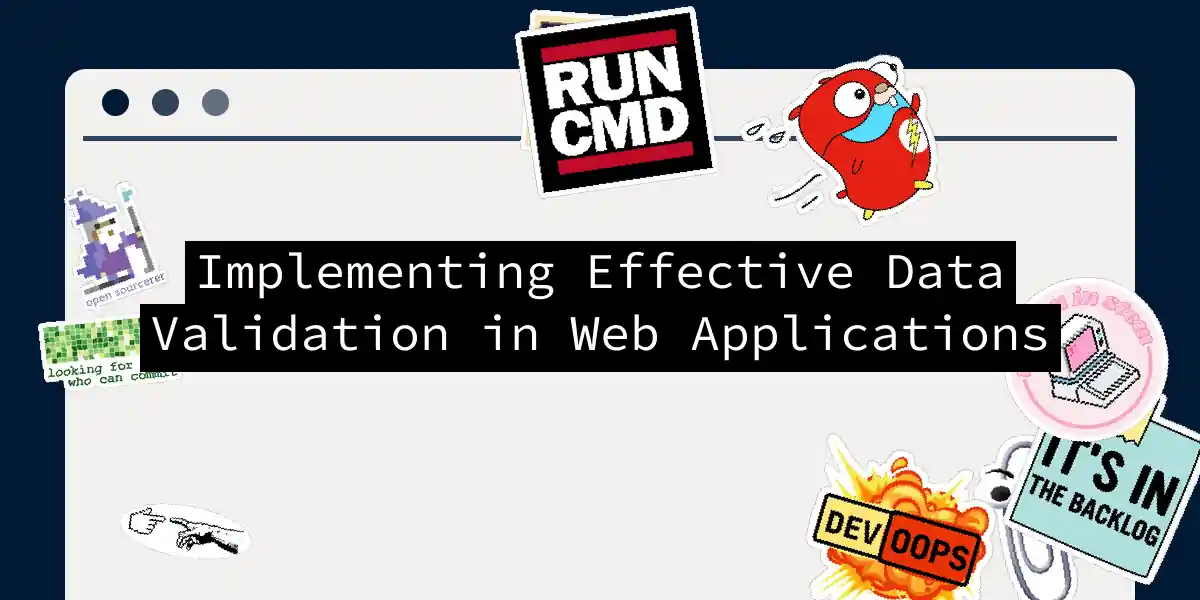The Importance of Data Validation
In the world of web applications, data validation is the unsung hero that saves the day from malicious attacks, user errors, and system crashes. It’s like having a bouncer at the club who ensures only the cool kids get in – in this case, the cool kids are valid and secure data. Without robust data validation, your application can end up like a party gone wrong, with guests you didn’t invite and a mess you can’t clean up.
The Three Levels of Data Validation
Data validation is not a one-trick pony; it’s a multi-layered process that involves the frontend, backend, and database. Here’s how each layer works:
Frontend Data Validation
The first line of defense is at the frontend, where the user interacts with your application. This level of validation is crucial for improving the user experience and reducing the load on your backend.
Why Frontend Validation?
- Immediate Feedback: Users get instant feedback if they make a mistake, which enhances their experience and reduces frustration.
- Reduced Server Load: Fewer invalid requests are sent to the server, making your application more efficient.
How to Implement Frontend Validation
You can use built-in form validation supported by modern browsers, write custom validation rules using JavaScript, or leverage libraries like React Hook Form or Formik.
// Example of simple frontend validation using JavaScript
const form = document.getElementById('myForm');
form.addEventListener('submit', function(event) {
const email = document.getElementById('email').value;
const password = document.getElementById('password').value;
if (!email || !password) {
alert('Please fill in both email and password');
event.preventDefault();
}
});
Backend Data Validation
While frontend validation is great for user experience, it can be bypassed by determined users. That’s where backend validation comes in – the fortress that protects your application from malicious inputs.
Why Backend Validation?
- Security: Backend validation ensures that data is validated on the server, preventing bypassing by users.
- Data Integrity: It enforces business rules and ensures data consistency before it’s stored in the database.
How to Implement Backend Validation
Using a backend framework like Django, Rails, or Laravel, you can validate data in the model or controller.
# Example of backend validation using Django
from django.core.exceptions import ValidationError
from django.db import models
class User(models.Model):
email = models.EmailField(unique=True)
password = models.CharField(max_length=128)
def clean(self):
if not self.email or not self.password:
raise ValidationError('Email and password are required')
Database Data Validation
The final layer of defense is at the database level. Here, you ensure that the data conforms to the rules defined in the database schema.
Why Database Validation?
- Data Consistency: Ensures that data types and constraints are enforced, preventing invalid data from being stored.
- Integrity: Maintains referential integrity and enforces business rules at the database level.
How to Implement Database Validation
Use database constraints and schema definitions to enforce data validation.
-- Example of database constraint in SQL
CREATE TABLE Users (
id INT PRIMARY KEY,
email VARCHAR(255) UNIQUE NOT NULL,
password VARCHAR(128) NOT NULL,
age INT CHECK (age >= 18)
);
Data Validation Strategies
Syntactic and Semantic Validation
Validation should be applied at both syntactic and semantic levels:
- Syntactic Validation: Ensures the correct syntax of structured fields (e.g., SSN, date, currency symbol).
- Semantic Validation: Ensures the correctness of values in the specific business context (e.g., start date is before end date, price is within expected range).
Client-Side vs Server-Side Validation
While client-side validation improves user experience, it must be complemented by server-side validation for security.
Input Sanitization
Input sanitization is crucial for removing or neutralizing potentially harmful content from user inputs.
// Example of input sanitization using JavaScript
function sanitizeInput(input) {
return input.replace(/<script>.*?<\/script>/g, '');
}
const userInput = '<script>alert("XSS")</script>';
const sanitizedInput = sanitizeInput(userInput);
console.log(sanitizedInput); // Output: ''
Best Practices for Data Validation
Define Clear Validation Rules
Clear and unambiguous rules are essential for effective data validation. This includes field-level validation, consistent data types, and explicit data formats.
Implement Automated Validation
Automate validation processes to ensure consistency and reduce human errors. Use tools and frameworks that support automated validation.
Regular Monitoring and Auditing
Regularly monitor and audit your data validation processes to maintain data integrity and identify discrepancies early.
Data Profiling Techniques
Use data profiling techniques to investigate the general health of your data and detect inconsistencies and errors. This helps in improving the fidelity of your data.
Ensure Data Security and Privacy
Data security and privacy are paramount during validation. Implement measures like user authentication, encryption, and the principle of least privilege to protect sensitive data.
Handling Validation Errors
Validation errors are inevitable, but how you handle them can make a big difference. Here are some tips:
Informative Error Messages
Provide clear and informative error messages that guide users on how to correct their inputs.
// Example of handling validation errors with informative messages
function validateForm(form) {
const email = form.email.value;
const password = form.password.value;
if (!email || !password) {
alert('Please fill in both email and password');
return false;
}
// Additional validation logic here
return true;
}
Error-Handling Mechanisms
Implement error-handling mechanisms to prevent invalid data from being processed or stored. This can include logging errors and notifying the development team.
Conclusion
Data validation is not just a necessity; it’s a game-changer for web applications. By implementing validation at the frontend, backend, and database levels, you ensure that your application is secure, reliable, and user-friendly. Remember, validation is an ongoing process that requires continuous improvements and updates. So, keep your validation rules sharp, your data clean, and your users happy.
And as a final tip, always keep in mind that data validation is like baking a cake – you need to follow the recipe carefully, or you might end up with a mess that’s hard to clean up. Happy coding
